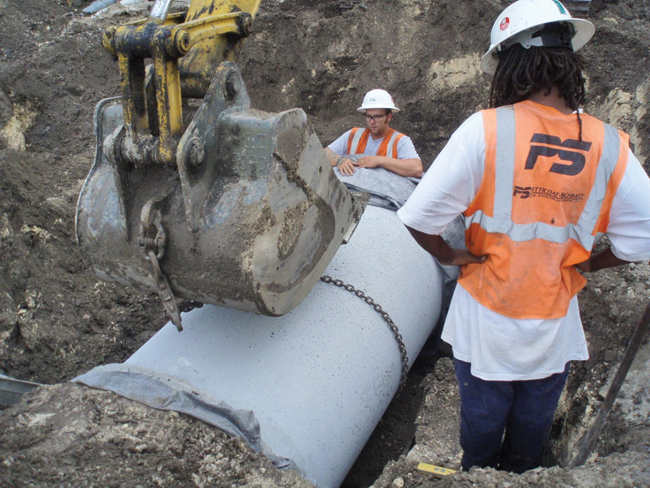We Dig Our Jobs
It’s no secret that the last few years have been tough ones for the construction industry. With the unemployment rate still very high (it jumped back to 16 percent in December) and the amount of available jobs dwindling, it’s been particularly stressful for companies to maintain a healthy bottom line, as well as retain an experienced crew. For those employers lucky enough to avoid making cuts to their workforce, now is the time where it’s essential to keep everyone in the loop and feeling secure about their place within the company.
“Existing staff is working harder than ever and many are taking on additional workloads due to reduced staff and trying to improve output,” explains Ryan Schmitt, president of Petticoat-Schmitt Civil Contractors Inc. “It is more important than ever to keep your staff informed and motivated by strong leadership and a clear strategy.”

Communication is key when reassuring employees about the economy and how they’ll be able to keep their
livelihoods in tact. Staying truthful about company operations is essential during a time when others in the industry may be struggling.
“Employees want to know the truth about what their company is doing in its attempts to find work and keep its employees busy,” says Bruce Wendorf, president of Forsberg Construction Inc. “They want to know the realities of how hard this economy is making it to stay in business. They want to know that the business is doing everything it can to survive, just as the employees are doing everything they can to help the company survive. Open and honest dialogue is extremely valuable when times are uncertain. Where there is truth, there’s hope.”
Schmitt adds, “In this economy, employees want to be informed about the status of the company and they want to hear a strategy on how the company will move forward. Times are tough, and benefits and/or salaries may have to be cut, but employees can respect that if leaders are candid, truthful and fair. However, employees also want to be part of the plan that will get the company through this tough economy. If there is any time for an owner to be fully engaged day-in and day-out with their company, it’s now.”
Aside from enjoying open communication, employees are simply grateful for staying on the job — with the unemployment rate currently hovering around 13 percent in the construction industry. With so many hard-working construction professionals out of jobs, there’s an even greater appreciation for keeping busy in the field.

“The guarantee of future employment on the current backlog of work is the best incentive as bonuses have dried up due to over-competitiveness in the market,” says Wendorf. “Employees have never been so appreciative of a job as a result of this sluggish economy.”
And the appreciation goes both ways. Employers are working to make their crews feel like a top priority and are encouraging them to stay productive despite the gloomy economic forecast. Although companies may not be able to show gratitude with extra cash, a good pat on the back is certainly one effective way of making up for it.
“While monetary resources for rewards are scarce, it is very important to recognize good performance through alternative methods,” says Schmitt. “Verbal recognition by company leaders plays a vital role in keeping hard-working crewmembers.”
Although verbal praise is a helpful way to make employees feel good about their job performance, it also works to reinforce behavior that’s expected on the job. When other workers see and hear a fellow employee doing a job well, they may be encouraged to do the same.
“We provide our field supervisors with weekly job cost feedback,” says Schmitt. “We want them to take ownership for their production and safety performance. The data they receive shows when they have met production goals and if so, how it has affected that particular cost code. This data — coupled with supervisors recognizing when good performers have done well — goes a long way to incent our front line managers. We also train and give feedback for effective job organization methods. We informally recognize good performers throughout the year, and at the end of the year, we have formal awards that recognize team members in the area of safety and all around performance.”
Training for Success
For companies that are able to add to their crews at this time, training is a vital step when bringing in a new worker. It’s especially important to strengthen their experience with the proper training for the jobs they’re expected to take on. This is where having seasoned employees comes in handy to show a newbie the ropes.
“Underground utility work is oftentimes very unique and non-repetitive,” says Wendorf. “This makes training particularly important as it relates to the details of a job, but the training must come from someone with the experience to understand the end result and how best to achieve that result safely and cost effectively. Maintaining a well trained crew is the result of maintaining experienced leadership in the field.”

With a new employee, training is typically the first step for most companies. By establishing the importance of training early on, an employee can begin his or her career on the right — and safe — foot.
“Training starts with the orientation process with all Petticoat-Schmitt employees,” says Schmitt. “From there, employees receive training in all safety aspects of our industry, management and leadership principles. Training topics include: Competent Person; Confined Space; OSHA 10-Hour Safety; Lifting and Rigging; Utility Locating; Cut-off Saw Training; One-Minute Manager; and the NUCA Pipelayer Training Series. We also send our office staff to software and management training.”
One of the most important parts of a training program is safety. Since a new employee is expected to work with equipment and in potentially dangerous situations, companies need to make sure their crews are well prepared for the tasks at hand — from day one and beyond.
“You teach safety once, you reinforce it forever,” says Wendorf. “The unavoidable cliché is ‘safety is a culture.’”
In addition to training sessions, employers need to stress the importance of safety on a daily basis. Whether it’s through incentive programs or meetings, companies should make safety a top priority and emphasize it to their crews.
“Safety is our first priority on all projects,” says Schmitt. “We have annual safety performance goals for the
whole company and we track our safety performance by project and a front line supervisor. Weekly job meetings, run by the president, start with a safety discussion on each project before quality, schedule and other issues are discussed.”
Through developing a good training regimen, employers can feel confident that their staff is prepared for a project. One of the most rewarding ways to see if a program is working is customer satisfaction.
“To me, it’s a credit to your training program when customers are calling you to ask for individual employees by name to return and do more work,” says Ron Nunes, president of R.T. Nunes & Sons Inc.
As for veteran contractors or anyone looking to stay up-to-date on the latest trends and technologies, there are numerous outlets that offer training. However, it’s important to sift through what’s the most beneficial to your company’s needs before having your employees invest their time into it.
“There is plenty of information available to anyone who really wants it,” says Schmitt. “Anyone who says they are challenged to keep up with the latest technology is not looking or not trying. In fact, the speed of information that comes out can often be ‘information overload.’ There are many free publications that are specific to our industry that have updates on new technology, equipment, trends, etc. Often I have more trouble filtering through what I should read rather than struggling to find the information I really want.”
A New Generation
As the industry continues to move forward, both Schmitt and Wendorf agree that there are plenty of opportunities for young men and women to take advantage of in the utility construction industry. Schmitt mentions that business owners — large and small — are looking for the next young superstar to show talent, ambition and dedication to help lead their companies in the future.
“I speak to construction management students at our local university, and I stress to them that there are many opportunities in smaller specialty contractors that often go overlooked,” says Schmitt. “Many students are aware of the larger general contractors in our area and think that is their only career path opportunity. There are plenty of excavation and utility contractors where a young student could continue to build his education and experience and grow into a lucrative construction management career.”

With a younger generation of workers coming into the industry, companies are eager to add their fresh minds into the mix to learn about the business as well as new technologies. A newcomer’s enthusiasm, paired with his or her ability to become skilled at older and newer equipment, is being seen as a valuable selling point.
“As equipment becomes more technical, it is important for construction companies to have equipment managers that can understand both old and new technologies,” says Wendorf. “Managing equipment maintenance and repairs is a long-term career with the potential of providing very significant wages and benefits.”
Help Wanted
For contractors looking to find work or employers trying to fill positions, Schmitt recommends taking a look at Internet sources such as LinkedIn. These online tools can help narrow down the search for potential jobs and even offer companies another outlet to advertise their openings.
“The Internet provides plenty of opportunities for someone to find work,” explains Schmitt. “Social media is a great tool to get the word out that someone is looking for work or a company is looking to fill a position.”
Although the journey to a new job may be difficult, both Schmitt and Wendorf agree that persistence and professionalism pay off. When applying for a position, it’s important to be thorough and dedicated to the cause. “Be persistent and treat your job hunt like it’s a job,” says Schmitt. “Dedicate the time and professionalism it deserves.”
It also pays off to showcase skills and experience through a detailed résumé. This will allow a job candidate to highlight his or her credentials and why they would be a good fit for a company.
“The advantage of a good résumé is often overlooked by our skilled workforce,” says Wendorf. “The résumé provides much more depth about one’s abilities, education and competency than a standard job application. It is my opinion that a résumé is seen as a more serious attempt at employment than the job application. Demonstrating certifications, training or other accomplishments is also an attractive asset to put on a résumé.”
Pam Kleineke is associate editor of Compact Equipment, based in Peninsula, Ohio.
